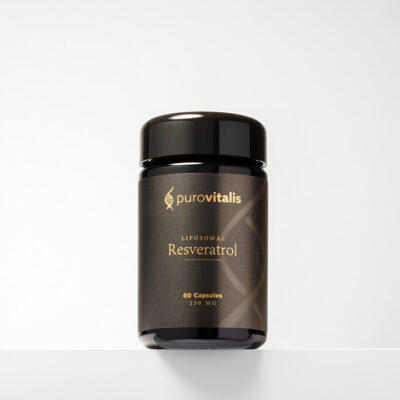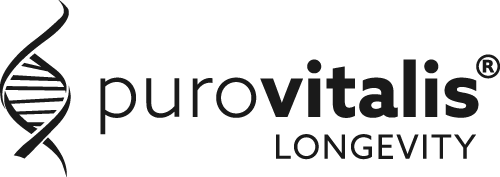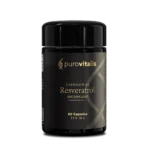
As women age, their bones gradually lose density. This process accelerates after menopause, when oestradiol levels drop and the balance between bone building and bone breakdown shifts [1]. The result can be a slow but steady weakening of the skeleton, often leading to osteoporosis and an increased risk of fractures later in life.
table of contents
While calcium, vitamin D, and strength training remain the foundation of any bone-health strategy, researchers have long been exploring whether certain natural compounds can offer extra protection [2]. One of the most intriguing candidates is resveratrol, a polyphenol found in red grapes, berries, and peanuts that has been studied for its potential anti-aging, anti-inflammatory, and cell-protective properties is resveratrol, a polyphenol found in red grapes, berries, and peanuts that has been studied for its potential anti-aging, anti-inflammatory, and cell-protective properties [3].
What is resveratrol?
Resveratrol belongs to a family of plant molecules called stilbenes, which plants produce as part of their defence system against stress [4]. Interestingly, this same mechanism seems to offer protection within the human body, too. In cells, resveratrol can activate longevity-associated pathways, enhance antioxidant defences, and improve mitochondrial function, all of which are linked to better cellular health and slower aging [5]. These effects have made resveratrol a focus of research in areas ranging from cardiovascular wellness to brain function [6,7]. But in recent years, scientists have turned their attention to an equally important target: bone health.
A closer look at the RESHAW study
A research team from the University of South Australia, led by Dr. Rachel Wong, set out to test whether resveratrol could directly influence bone strength in postmenopausal women. Their work, published in The Journal of Bone and Mineral Research, stands out as one of the most robust human studies to date on the topic [8].
The RESHAW study followed 125 postmenopausal women for two years. Each participant completed two phases: one year taking a placebo and one year taking 75 milligrams of resveratrol twice daily. The study was double-blind and randomized, meaning that neither the participants nor the researchers knew who received which treatment at any point. This “crossover” design allowed every woman to serve as her own control.
At the start of the trial, participants showed the range of bone health typically seen in postmenopausal women, from normal bone mass to osteopenia, the stage just before osteoporosis. Researchers measured bone mineral density at several key locations, focusing especially on the lumbar spine and femoral neck, two areas that are highly prone to fractures.
Related: Women’s age and fertility: Reproductive longevity and health
What the researchers found
After twelve months of taking resveratrol, the participants displayed measurable improvements in bone mineral density at both the spine and the femoral neck. These changes were modest but statistically significant, suggesting that the natural compound slowed bone loss and perhaps even stimulated subtle gains in density. Blood analyses confirmed a concurrent drop in CTX, a biochemical marker that indicates the rate of bone resorption.
What makes these findings notable is not just the numbers, but the biological consistency behind them. A reduction in bone breakdown, accompanied by improved density in critical load-bearing regions, points to a real physiological benefit. It indicates that resveratrol may help restore equilibrium between osteoclasts and osteoblasts a balance that tends to shift unfavourably with age.
Definition of osteoclasts and osteoblasts
While osteoclasts are cells that break down old or damaged bone tissue, osteoblasts are responsible for building new bone tissue.

The connection between blood flow and bone strength
The researchers also found an unexpected but meaningful relationship between bone density and vascular health. Women who experienced the strongest gains in bone density also demonstrated better micro-circulation in the femoral neck region. Bone, though often thought of as a static structure, is in fact a living organ that depends on constant nutrient and oxygen delivery.
As we age, blood vessels within bone tissue can become stiffer and less responsive, reducing nutrient flow and impeding the remodelling process. Resveratrol is already known for improving endothelial function; it helps blood vessels relax, enhances nitric oxide signalling, and protects against oxidative stress [9]. The observation that bone improvements were linked to better blood flow supports the idea that vascular health and bone metabolism are closely intertwined. Resveratrol seems to strengthen that connection.
Who benefited most and why
The benefits of resveratrol were most pronounced in women who began the study with lower bone density and in those who were already supplementing with calcium and vitamin D. This finding suggests that resveratrol doesn’t work in isolation but rather complements an already solid nutritional foundation. It’s a reminder that bone health is multifactorial, involving diet, hormones, exercise, and microcirculation, and that synergy among these factors may yield the best results.
What’s equally encouraging is resveratrol’s strong safety record. Over the two-year study period, no significant side effects were reported. The supplement was well-tolerated, easy to incorporate into daily life, and effective even in low doses compared to many prescription treatments. That makes it a realistic option for women seeking a gentle, natural approach to long-term bone support.
Why this study matters
Although the changes seen in this study were modest, they carry weight because of the study’s quality, duration, and clear biological rationale. In the world of nutritional science, finding consistent, measurable improvements in bone mineral density over a full year, in humans, not just animals, is no small achievement. The results strengthen the hypothesis that resveratrol’s benefits stem from multiple interconnected actions: supporting microvascular health, balancing bone cell activity, and counteracting low-grade inflammation.
These findings also broaden our understanding of aging itself. Healthy aging is not just about maintaining muscle mass or cognitive sharpness; it’s about keeping the body’s structure, the skeleton, strong and functional. By influencing both vascular and skeletal systems, resveratrol may represent a bridge between metabolic health and mobility, two cornerstones of quality of life in later years.
From science to daily life
At Purovitalis, we’ve taken these insights to heart. Our resveratrol supplement is crafted with high-purity, bioavailable trans-resveratrol, the same form used in clinical studies like the RESHAW trial. It’s formulated to help maintain healthy blood flow, support bone metabolism, and promote overall cellular vitality.
For postmenopausal women looking to stay active and strong, resveratrol represents a small but powerful addition to a lifestyle that already includes movement, sunlight, balanced nutrition, and self-care. Science continues to uncover how this natural molecule supports longevity and structural strength from the inside out. While resveratrol isn’t a cure or a shortcut, it may be one of nature’s most elegant tools to help the body preserve what matters most: resilience, mobility, and confidence through every stage of life.
References
- Ji MX, Yu Q. Primary osteoporosis in postmenopausal women. Chronic Dis Transl Med. 2015 Mar 21;1(1):9–13.
- Laird E, Ward M, McSorley E, Strain JJ, Wallace J. Vitamin D and Bone Health; Potential Mechanisms. Nutrients. 2010 July 5;2(7):693–724.
- Zhang LX, Li CX, Kakar MU, Khan MS, Wu PF, Amir RM, et al. Resveratrol (RV): A pharmacological review and call for further research. Biomed Pharmacother. 2021 Nov 1;143:112164.
- Hasan MdM, Bae H. An Overview of Stress-Induced Resveratrol Synthesis in Grapes: Perspectives for Resveratrol-Enriched Grape Products. Mol J Synth Chem Nat Prod Chem. 2017 Feb 14;22(2):294.
- Ungvari Z, Sonntag WE, de Cabo R, Baur JA, Csiszar A. Mitochondrial Protection by Resveratrol. Exerc Sport Sci Rev. 2011 July;39(3):128–32.
- Cicero AFG, Ruscica M, Banach M. Resveratrol and cognitive decline: a clinician perspective. Arch Med Sci AMS. 2019 July;15(4):936–43.
- Gal R, Deres L, Toth K, Halmosi R, Habon T. The Effect of Resveratrol on the Cardiovascular System from Molecular Mechanisms to Clinical Results. Int J Mol Sci. 2021 Sept 21;22(18):10152.
- Wong RH, Thaung Zaw JJ, Xian CJ, Howe PR. Regular Supplementation With Resveratrol Improves Bone Mineral Density in Postmenopausal Women: A Randomized, Placebo-Controlled Trial. J Bone Miner Res Off J Am Soc Bone Miner Res. 2020 Nov;35(11):2121–31.
- Li H, Xia N, Hasselwander S, Daiber A. Resveratrol and Vascular Function. Int J Mol Sci. 2019 Apr 30;20(9):2155.

Liposomal Resveratrol maximum benefits improves sugar levels
Experience the best of resveratrol with Purovitalis liposomal formula. Try it out!










